 I love painted buttons but it a major operation for me and tends to make a huge mess so I usually paint a couple dozen at a time... Although painting roses is the fastest and easiest, I prefer to paint birds and cottages. Although I repeat them all the time people always want to skip the prep steps... Bad choice!!!
I love painted buttons but it a major operation for me and tends to make a huge mess so I usually paint a couple dozen at a time... Although painting roses is the fastest and easiest, I prefer to paint birds and cottages. Although I repeat them all the time people always want to skip the prep steps... Bad choice!!!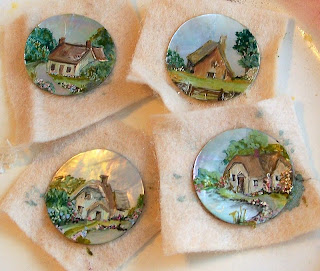 Critical Preparation: First glue the button to a scrap of felt. If the button has a shank cut a hole in center of felt so you can glue felt tightly to the botton of button... In addition to giving you a handle while painting, the felt will provide a surface for beading and attaching to your block... This felt gives you a handle so you do not touch the button itself. It to easy to get oil from your fingers on the button surface or smear your work. Plus it's tiring holding a 1" button steady.
Critical Preparation: First glue the button to a scrap of felt. If the button has a shank cut a hole in center of felt so you can glue felt tightly to the botton of button... In addition to giving you a handle while painting, the felt will provide a surface for beading and attaching to your block... This felt gives you a handle so you do not touch the button itself. It to easy to get oil from your fingers on the button surface or smear your work. Plus it's tiring holding a 1" button steady.
Once dry, fill any holes with any white putty from the hardware store sometimes called spackle and it is sold in the paint department in small containers. Whether it's gray or white doesn't really matter as you're going to paint over it ... But with birds or roses the holes may be awkward so I like the white.... If you look closely at the cardinal below you can see the filled holes under his body but after it is finished they will hardly be noticeable.....
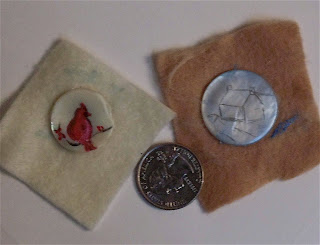 Then sand button lightly with fine sandpaper. Unless you sand the surface the paint tends to "puddle" on the surface...
Then sand button lightly with fine sandpaper. Unless you sand the surface the paint tends to "puddle" on the surface...Now for the most important prep step. Brush a very thin layer of blue wash (blue paint mixed with water) over the button. This must dry or cure. I leave it sit overnight. The wash gives the button a tooth or surface that makes painting soooooooo much easier and it is thin enough to let the luminosity of the button shine through .
You can see other buttons I've painted on my other blog.... http://olderrose.blogspot.com/search/label/button%20painting.
Now the next step..... The button on the right has been glued to felt, sanded and covered with a thin coat of blue wash...I sketch the shape of a cottage with a pencil. Start with a very simple shape. If you are uncertain of your drawing skills. Reduce a simple cottage shape to size of button, cut it out and trace around it...Now we're ready for next step... stage 2
I've done this tutorial twice before but now that we can add pages to our blog I'm updating it and now it is all on it's own page..
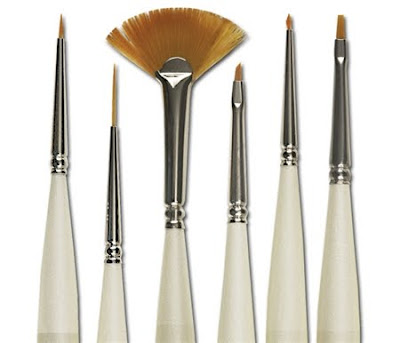 BRUSHES: You'll never have any great amount of success unless you have really tiny brushes... It is confusing to stand in front of the brush section of an art or hobby store because there are so many sizes and styles. I don't recommend buying a set like on the left because you just won't use all of them and you'd be better off buying extra of the brushes that you will use all the time.
BRUSHES: You'll never have any great amount of success unless you have really tiny brushes... It is confusing to stand in front of the brush section of an art or hobby store because there are so many sizes and styles. I don't recommend buying a set like on the left because you just won't use all of them and you'd be better off buying extra of the brushes that you will use all the time.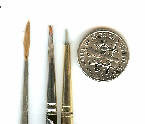 Lots of sites and stores sell sets of mini-brushes with 6-15 types in a set but I only use three types.... All are 10/0 which means ten zeros.... brushes smaller than that are hard to find....
Lots of sites and stores sell sets of mini-brushes with 6-15 types in a set but I only use three types.... All are 10/0 which means ten zeros.... brushes smaller than that are hard to find....
1. Liner...a long thin brush.... My favorite is American Painter 4350 10/0 but any 10/0 liner will do... A liner is indispensable for fine detail on stems, feathers, flowers, etc.
2. Spotter...a small round with a delicate point..... My favorite is American Painter 4650 10/0 Since you are working so small it is really cheating with dots for lots of the detail... And that is what a "Spotter" is made for.... making dots... If you make enough dots your work will be fantastic....
3. Angular Shader... A favorite with tole painters, this brush requires a little practice to use to your best advantage... You could get along just fine with just a liner and a spotter but I recommend at least trying an angular brush.... My favorite is Loew Cornell Angular 7400 10/0 as it's great for leaves and flower petals....
 If you dip the angular brush in pink and then dip just the very tip in white and pull it sideways or in an arch, you get the same effect as you do an an ombre ribbon...a two-tone effect. If you make a C and then a backward C together you end up with something that looks like a little donut...great for rose centers and rose buds...
If you dip the angular brush in pink and then dip just the very tip in white and pull it sideways or in an arch, you get the same effect as you do an an ombre ribbon...a two-tone effect. If you make a C and then a backward C together you end up with something that looks like a little donut...great for rose centers and rose buds...
Thank heavens these brushes are not that expensive because being so small they do not last that long if you do much painting... I do not buy expensive brushes because they need to be replaced quite often.
Personally I just buy my brushes at Michaels (our local big chain craft store) when they have a sale... But sometimes the selection at a hobby store is limited or out of stock and if you don't have access to a hobby or art store here are some online options..
1. VERY inexpensive source for my favorite liner and spotter...... http://pearlpaint.com/shop-Brush-SH-4000series-American-Painter_7810_78115.html These are so cheap buy 2 or 3 of each..
2. For some reason tiny angular brushes are a little harder to find...but my favorite is available at
http://www.in2art.com/art-supplies/loewcornell-goldentaklon-artistbrushes They also carry perfectly fine 10/0 liners and spotters.
PAINTS: To start I'd recommend white, yellow, royal blue, dark and light green, dark pink or burgundy and a medium pink and a dark brown. With these few colors you can paint most anything... I just buy inexpensive acrylics at the craft store and often find bags of them at thrift stores.
Next actual painting plus painting a rose...it takes absolutely NO artistic talent to paint tiny roses...it's all cheating ..believe me.. I will show you..
P.S. Great tip: the next time you are at a $ store or a box store pick up a whisk broom... Those little straws are great for mixing small amounts of paint and getting tiny bits from the bottom of the bottle... Better yet save the cup stoppers from coffee shops.
In this part I'm going to discuss paints and techniques and the last part I will demonstrate roses that ANYONE can do.....in fact a couple ways.... Ever wonder why almost all the buttons for sale have roses painted on them? It's because roses are the easiest thing to paint on buttons..
Step 1. Prepare the button which we have covered.
Step 2. Doing the "base coat" for roses or birds or cottages or whatever..... This is when your button will look the absolute worst and when most people want to quit... I forbid you to become discouraged at the base coat stage... everything is blotchy, flat and really looks ugly....but it is a critical stage. Also at this point it is often best to dab in some background color for foliage etc.
Thin your paints...I use just water and cheap paint. Work in layers and let dry between layers. The end product will look much better if you use three thin layers rather than one thick layer of paint... Also after the base coat I let the button dry several hours, even overnight... You are working on a hard non-absorbent surface.... If you work over paint that is not completely dry (even if it feels dry) it can sometimes lift right off the surface... So speaking from experience I take my time between steps...
Step 3. Doing the detail over the base coat... The nice thing about acrylics is they're very forgiving and mistakes can be painted right over. If you make a mistake it best not to try to rub it off....just let it dry... Then you can paint over it or gently scrape it off with the tip of a exacto knife.
The nice thing about working small is the lack of detail... so by using lots and lots of dots and general shapes you can fool about any one's eye.....
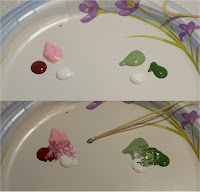 Here is the way I mix paints to use on the buttons and I highly recommend this technique.. For example: In a triangle I put a dab of a light green, a dark green and white with some space in the center of the little triangle... Then I take a straw from my whisk broom and make a puddle of the three colors in the middle of the triangle...DO NOT MIX WELL... leave it streaky... so every time you dip your brush you get a slightly different mix and never the same mix so you have a very painterly look with little effort or color knowledge.... Cheating? maybe....
Here is the way I mix paints to use on the buttons and I highly recommend this technique.. For example: In a triangle I put a dab of a light green, a dark green and white with some space in the center of the little triangle... Then I take a straw from my whisk broom and make a puddle of the three colors in the middle of the triangle...DO NOT MIX WELL... leave it streaky... so every time you dip your brush you get a slightly different mix and never the same mix so you have a very painterly look with little effort or color knowledge.... Cheating? maybe....
You can use your spotter or liner for the dots. If you just lay your spotter or angular shader on it's side you can get a nice leaf shape... If you lay it on it's side and pull, you get a nice comma shape. The liner is super for lines, stems and long commas or eyebrow shapes... When you are working with a liner I find it easier to pull the line toward me even if it means turning your button upside down...
If you are unfamiliar with brushes I recommend you take some time practicing with each brush...especially making dots... I make more dots than anything else in painting my buttons... You need to develop a VERY light touch to make tiny dots. This is not artistic talent ...just practice. Being able to make tiny dots is the key to success... So play with your brushes and make 100 tiny tiny dots..... I'll also cover in the next part the final finishing touches.. and we paint!!!!!
Part 1.
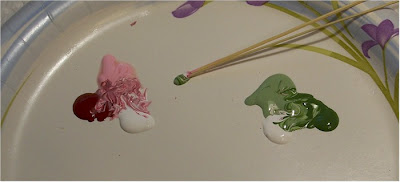
Part. 2
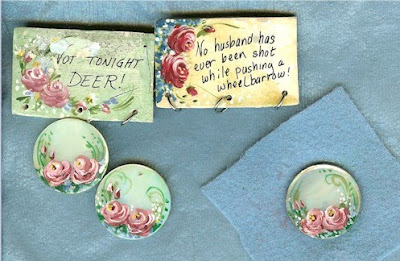 These are examples of some rose buttons I painted and also some rejects of pins I used to paint. I included them because I wanted you to look closely and see all the dots (especially white dots) I added at the end... These dots add light and interest to the composition..
These are examples of some rose buttons I painted and also some rejects of pins I used to paint. I included them because I wanted you to look closely and see all the dots (especially white dots) I added at the end... These dots add light and interest to the composition..
When you're done, spray your button with about 6 thin coats of a clear acrylic coating. I use Kryon's Crystal Clear. Then I put a little "Antique Gold" Rub n Buff on the edge of the button for a finishing touch. If I'm going to bead around the button I do it BEFORE I trim the felt. If you're not going to bead just trim the felt very close and taper cut under edge of button....
Remember blob...nub/knot....and concentric lines!!!!
Just keep going around the nub and build your rose and remember to keep dipping in different parts of your "streaky puddle."
If you try this please give me feedback .. Thanks... Gerry







.jpg)

15 comments:
It´s wonderful, fantastic, grandiose....
I don´t have enaugh engl. words.
ONLY GREAT.
LG,
Helga
This is a great tutorial. Thank you! I think even I could paint a rose with your instructions.
What great instructions. Maybe even I could paint a rose now. :-)
Great great tutorial. Thank you for sharing what you've learned through experience...means a lot and will save people from making as many mistakes. Appreciate what you've done!
This is so exciting! I've just found your blog via Freda of 'Sew Whats New'.
Don't forget to visit her as she has a giveaway for her 300th post!!
Your tutorial has inspired me to buy some plain buttons and have a go!! I've always been a buttonholic as well as a Francofile!
You're a generous spirit to share your knowledge with us in this way - thank you so much.
Hugs from New Zealand
Shane
Thank you very much for this nice turtorial - a very nice idea :)
Thank you for the help.I just boughtsome button to paint on .Your hint are so good.Found you though Mosaic Magpie Laura
Thank you for sharing this great technique - the results look wonderful!
Great tutorial! So... If I have some ugly plastic shank buttons, can I just sand them and paint an opaque base coat?
I just love these buttons. I want to do the same thing except on small stones. Then make pins from them. I never thought about buttons........great idea.
Lovely work
Janice
Thank You for posting this great tutorial! Love your buttons
Thak you for the teaching lesson...I have some new ideas now. Peace, Mary Helen Fernandez Stewart
GREAT TUTORIAL
Oh Gerry, I really didnt need another hobby..... I am utterly inspired to give this a try though. You instructions are so clear
Hi! After you use putty to fill the holes doyou take the putty out of the holes once everything is painted and sprayed? What’s more desirable? I could see people not wanting the holes plugged up. Thank you!
Post a Comment